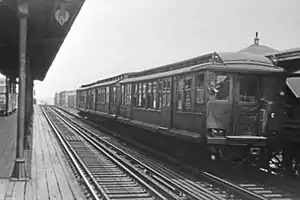C-type (New York City Subway car)
The C-type was a series of elevated New York City Subway cars originally built by the Osgood-Bradley, Brill, Laconia, and Jewett car companies, and rebuilt by the Brooklyn Rapid Transit Company between 1923 and 1925 from former BU cars. These cars were one of the two car types to be rebuilt by the BMT from BU cars, the other being the Q-types.
| C-type | |
|---|---|
 A C-type train at Crescent Street on the former BMT Fulton Street Line. | |
| In service | 1923–1956 |
| Manufacturer | Osgood Bradley Car Company J. G. Brill Company Laconia Car Company Jewett Car Company Brooklyn Rapid Transit Company |
| Constructed | 1923–1925 |
| Number built | 90 cars assembled into 30 units |
| Number preserved | 0 |
| Number scrapped | 90 |
| Formation | Three-car sets |
| Fleet numbers | 1500–1529 A-B-C |
| Capacity | 46 (A and C cars), 44 (B car) |
| Operator(s) | Brooklyn Rapid Transit |
| Specifications | |
| Car body construction | (Motorized end cars) steel underframe, upright body members, and motorman's cab, remainder wood and canvas. (Trailer center cars) substantially wood construction with steel hardware and turnbuckles. |
| Train length | 137 feet (41.8 m) over the extreme ends of each unit |
| Car length | 49 feet 3 inches (15.01 m) |
| Width | 8 feet 9 inches (2.67 m), but ~10 feet (3.05 m) with roof and floor extension to reach platforms without creating a gap. |
| Height | varied, approximately 10 feet 5 inches (3.18 m) |
| Weight | 76,970 lb (34,913 kg) (A and C cars), 43,170 lb (19,582 kg) (B car) |
| Traction system | WH USG251-1-3 WH 300 WH 50L |
| Power output | 200 hp (150 kW), 150 hp (110 kW) |
| Track gauge | 4 ft 8 1⁄2 in (1,435 mm) |
Description and history
The C-types were numbered 1500–1529 A-B-C. Each C-type unit contained 3 cars semi-permanently coupled to form an operating unit. They consisted of a relatively modern steel-framed motor car at each end, originally built in 1903 (former 1200 series car) or 1907 (former 1400 series car) and a steam-era trailer car in the middle, originally built in 1893 (former 100 series car). All of the conversions were done in the shops of the BRT.
The conversion was done in order to create a fleet of elevated cars with automatic door controls capable of operating on the BMT Fulton Street Line, whose station platforms had been redone to accommodate 10-foot (3.05 m)-wide equipment instead of the standard 8-foot-9-inch (2.67 m)-wide elevated cars. The gates and platforms at the ends of each three-car unit were enclosed and a motorman's cab placed in each.
The interior gates and platforms of individual cars were removed, and passageways were created between the cars in each unit so passengers could walk from car to car without going outside. Two doorways were cut into each side of each car of the unit, and outside-hung sliding doors were attached to the cars. Despite the C-type's general appearance and the passageways between cars, they were not articulated units, since each car of the unit could stand alone on its own two trucks, while articulated units share trucks underneath the inter-car passageway.
The prototypes of the C-type units, created in 1923, presented a fairly neat appearance. However, the production cars created in 1925, with their varying roof heights, floor extensions to reach the platforms, and roof extensions to contain the hangers for the sliding doors presented such an ungainly appearance that they have been popularly characterized as the ugliest equipment ever to run on the New York City subway system. These cars were nicknamed the "ugly ducklings" because of their appearance.
Despite criticism, many of the C-types remained in passenger service until 1956, when the last original portions of the Fulton Street elevated were abandoned and later demolished. The C-types also ran from Manhattan over the 14th Street Line and connected with the Fulton Street Line in East New York during rush hours, sharing their route with the MS Multi-section cars.[1][2] No examples of this car were preserved.